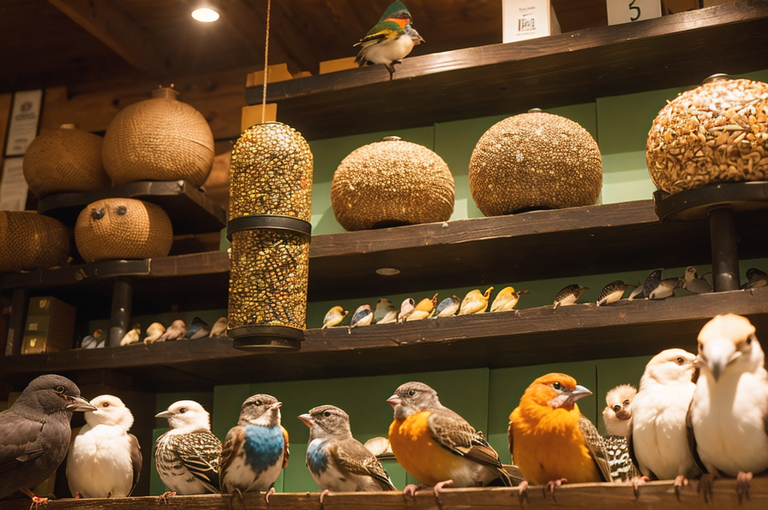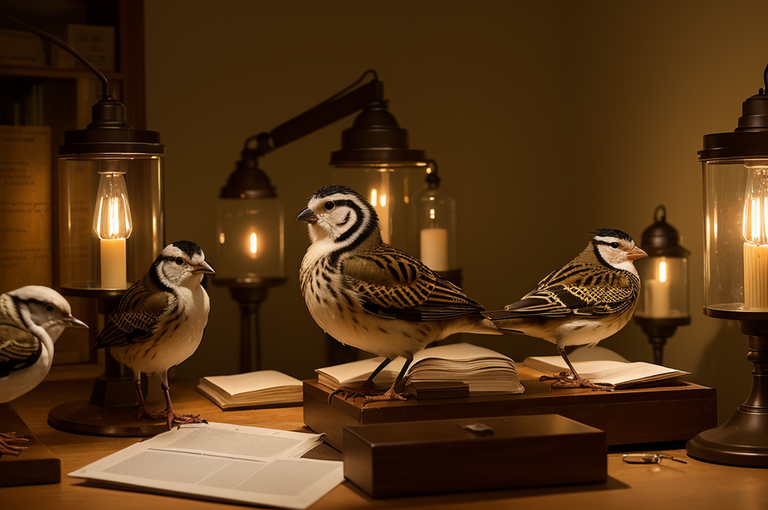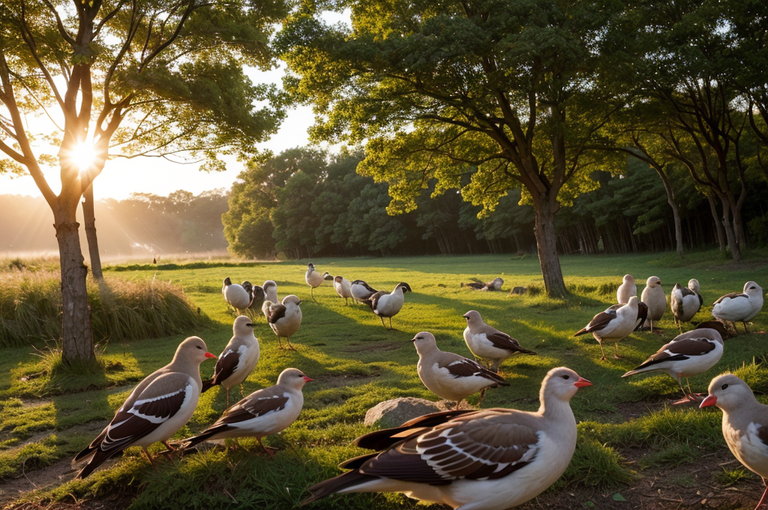The Art of Bird Feeding: Health, Nutrition, and Safety Measures for Your Feathered Friends

The article discusses the popular practice of feeding wild birds, detailing types of bird food, cleanliness of feeders, bird-feeder locations, and the importance of providing fresh water. It also warns about over-dependency and potential starvation of birds.
The Importance and Precautions of Feeding Wild Birds
In the quiet sanctum of my home, amidst the multitude of wild birds images that adorn my walls, there’s a specific activity that I’ve adopted as a compelling ritual feeding my feathered friends. It’s an activity that’s rapidly becoming prevalent among bird enthusiasts and everyday citizens alike.
The popularity of bird feeding
There’s an inexplicable charm in hand feeding a lively chickadee or watching a multitude of colorful finches hustle for sunflower seeds in the backyard. During harsh winters, when the world outside seems like a stark, frozen landscape, the simple act of feeding birds can infuse life and hope into the air.
Importance to the birdseed industry
Unbeknownst to many, this benevolent act weaves significant threads into the economic fabric. Bird feeding indirectly bolsters the birdseed industry, demonstrating an element of economic importance that often goes unnoticed. It’s a fairly modest, yet nuanced symbiosis that enriches both our everyday life and the bustling birdseed economy.
Risks of dependency and cessation
However, our well intended endeavors occasionally have undesired effects. There lies a potential risk of dependence that can prove perilous for our avian companions. If we abruptly stop feeding, it could lead to starvation in birds that have grown accustomed to our assistance, particularly during winter when their natural food sources are scarce. Hence, consistent care and responsibility are vital to mitigate risks.
In essence, it’s crucial that we wear the mantle of bird feeding with a keen awareness of its sanctity and implications it’s not a mere pastime, but an ethical commitment to our feathered friends. So, as you bask in the enchanting spectacle of wild birds images in your backyard, remember the consequences your actions could have on their survival.

Types of Bird Food and Preferences
Ah, the age old question of what to feed a wild bird. It’s a conundrum we’ve all faced. Different species, you see, have distinct tastes. I’ve observed that many are partial to hulled sunflower seeds, black oil sunflower seeds, peanut hearts, and cracked corn. Let’s not forget suet, either the beef fat provides an energy boost that’s just irresistible to these lovely creatures.
Different Bird Species’ Preferences
I love that every bird has its peculiar palate. Hulled sunflower is quite versatile you’ll see everything from cardinals to juncos hopping to have a beak full. Whereas black oil sunflower seeds and peanut hearts ah, those are like a song for the finches and grosbeaks. Cracked corn is quite popular among the ground feeding crowd, think sparrows and doves.
Popular Foods Among North American Birds
Of course, there are some universal favorites present in North America. These beautiful beings enjoy feasting on black sunflower seeds, unsalted peanuts, crushed peanuts, and suet blocks. And the joy of watching them devour with gusto, my dear readers, is unparalleled.
Using Garden Plants as Bird Food
And then, we have our wonderful garden plants – a natural smorgasbord! Take echinacea, for instance. Its seed heads remain long into winter, providing a lifeline when other sources are scarce. It’s quite the feast for the goldfinches and other seed loving birds. I do urge you, the next time your fingers itch for some gardening think of our feathered friends. Plant with them in mind.
Remember, the joy of birding isn’t only found in observing in offering sustenance, we partake in their delicate world. We become more than mere spectators; we become active contributors to the preservation and care of our charming avian neighbors.

Importance of Cleanliness & Maintenance of Bird Feeders
Picture this, seasoned observer and bird lover, you meticulously set up a bird feeder to attract our feathered friends. You’ve learned, perhaps questioned, what should i feed wild birds and filled it with suitable nourishment. But there’s more to it than just deciding what to feed. Let me introduce you to the art and importance of bird feeder hygiene.
Need for cleanliness and maintenance
Like a fine tuned watch, a bird feeder requires regular inspections and meticulous cleanliness to ruffle its full potential. It is like a dining table for birds, and no creature, winged or otherwise, should have to dine in a mess. Bird feeders are not just for your pleasurable view or for bird sustenance, they’re also potential hotspots for diseases. Imagine inviting our sky dancers to a petri dish of infection? Oh, the horror!
Routines for ensuring cleanliness
Locking feathers with this challenge, accustomed habits like changing water and semimonthly scrub downs of the feeders and the area surrounding it are not just recommended but vital. This task might appear Sisyphean, but rest assured that the reward is of an Olympian climb. The morning chorus of warblers or the flight of a returning starling the spectacle makes every effort worth it.
Importance of maintenance to prevent disease
Nurturing your bird feeder isn’t just a labor of love, but also a doting duty. Well kept feeders minimize potential risks, curtailing the spread of diseases among birds. Mix your fascination with responsibility a few spoonfuls of elbow grease and a dash of diligence, keeping an alert eye for any signs of trouble.
In this journey of connecting with the avian world, cleanliness and maintenance of bird feeders are stepping stones. They are not just tasks but elements of a ritual that embrace a bigger picture of stewardship and love for our feathered neighbors. Like writing, or bird watching, or maturing in life, it’s all in the details. A clean bird feeder is indeed a lighthouse, sending signals of care, respect, and love to the avian world.

Ideal Location for Bird Feeders
A question begs pondering, can wild birds eat raisins? That’s a question for another day. As an ornithologist and an avian enthusiast, deciding the perfect spot for bird feeders is an often overlooked task that comes with its set of considerations.
The Effect of Feeder Location on Bird Accessibility
Birds, like any creature, are creatures of comfort. They love convenience. They seek out feeders that require the least detour from their usual flight paths, without exposing them to undue risks. Easy accessibility is a deciding factor. Feeders need to be strategically located for easy accessibility and safe retreats for our feathered friends.
Safety Considerations in Location Planning
Birds require strategic thinkers. Their feeders need locations near cover, like trees or shrubs, perfect for swift exits from potential predators. Yet, inherently, one must be wary of attracting unwanted guests in the cloak of darkness. In places where bears are common, a word to the wise is to bring the feeders in at night. An alluring treat for a bear, we don’t want to invite trouble into the garden.
Specific Precautionary Measures
Indeed, in the avian realm, much like in life, precaution pays dividends. The placement of bird feeders becomes a significant exercise in ensuring the safety and happiness of our winged companions. They need to be high enough, clear of ground prowlers, and close to a haven of trees or shrubs. Perhaps a final, indispensable tip would be: clean regularly. Dirty feeders can be breeding grounds for disease, and we wouldn’t want to be responsible for an avian pandemic, would we now?
Perfecting the placement of bird feeders is another testament to our dedication to cohabiting with these natural wonders a small but significant step towards understanding and respecting their needs.
Supplying Water for Birds
If I’ve learned anything during my many mornings watching wild birds, it’s that a steady intake of hydration is as imperative to them as food. When contemplating what to feed a wild bird, it’s crucial to consider their needs beyond nourishment. Birds thrive when in frequent access to fresh, standing water serving not only as a thirst quencher but as an essential element of their hygiene routine.
The Necessity of Providing Water
Satiating the thirst of these winged wonders involves more than sparsely filled birdbaths. It’s a responsibility akin to continuously replenishing their feeders a commitment embedded in the very idea of bird care. Their reliance on us mirrors our fascination with their existence, creating a symbiotic connection that is beautifully fulfilling.
Water as a Source of Hydration and Hygiene for Birds
Now you might be wondering, what should I feed wild birds? Well, for starters, actual feeding involves more than just sustenance. It envelopes every aspect of their survival, including their hydration and hygiene. You see, birds, unlike the feathered figurines seen in wild birds images, enjoy a good soak. They splash, preen, and fluff, and as they do, they remove the day’s dust, parasites and align each feather perfectly for flight.
Best Practices for Providing Water
When providing water, consistency is key. Regular access to clean, standing water can be just as valuable, if not more so, than a diet rich in seeds, insects, or tantalizing raisins. And yes, wild birds can eat raisins, but a raisin alone will do little to quench thirst or clean feathers. Position your water sources mindfully, away from feeder droppings and in secure locations. Regular cleaning is necessary to prevent the proliferation of diseases that can deter and harm your colorful companions.
As you observe the birds flock to your well stocked water source, you’ll realize the impact of your gestures. Their chirps become a melody of gratitude, their vibrant plumage a testament to their health. In the heart of every bird watcher, it resonates a satisfying echo, reaffirming a bond that transcends species.


